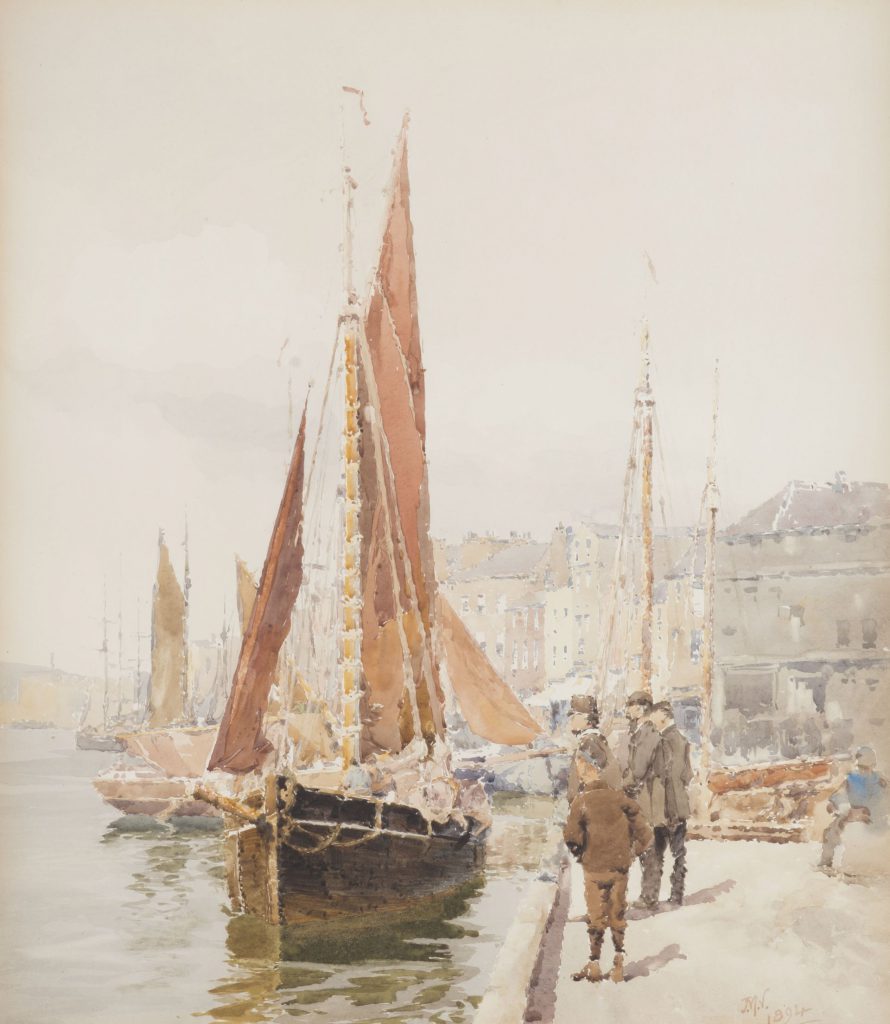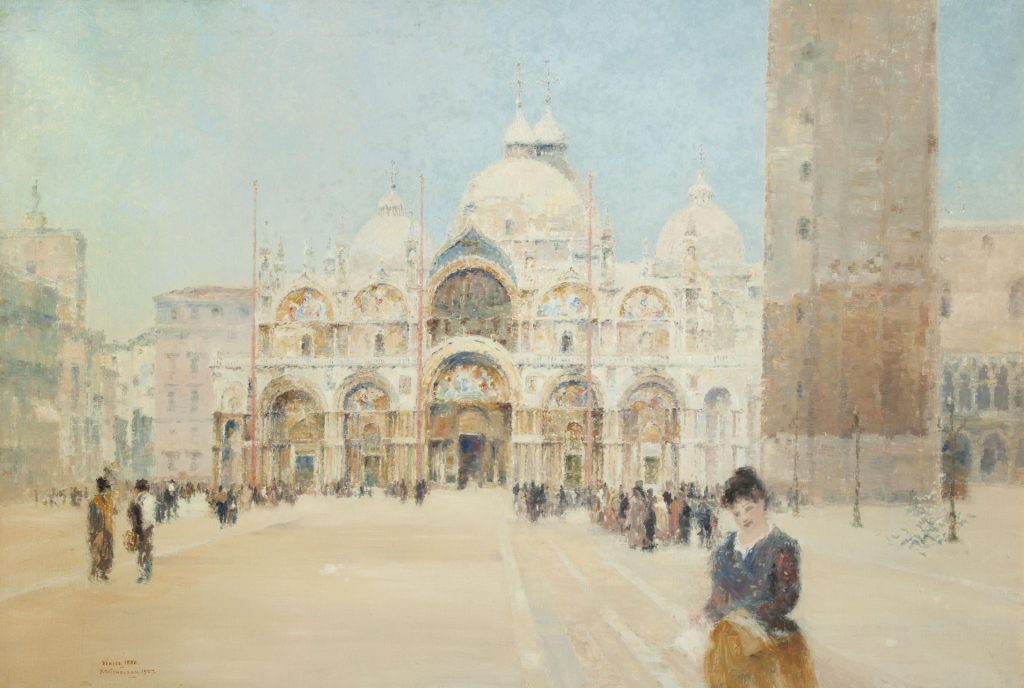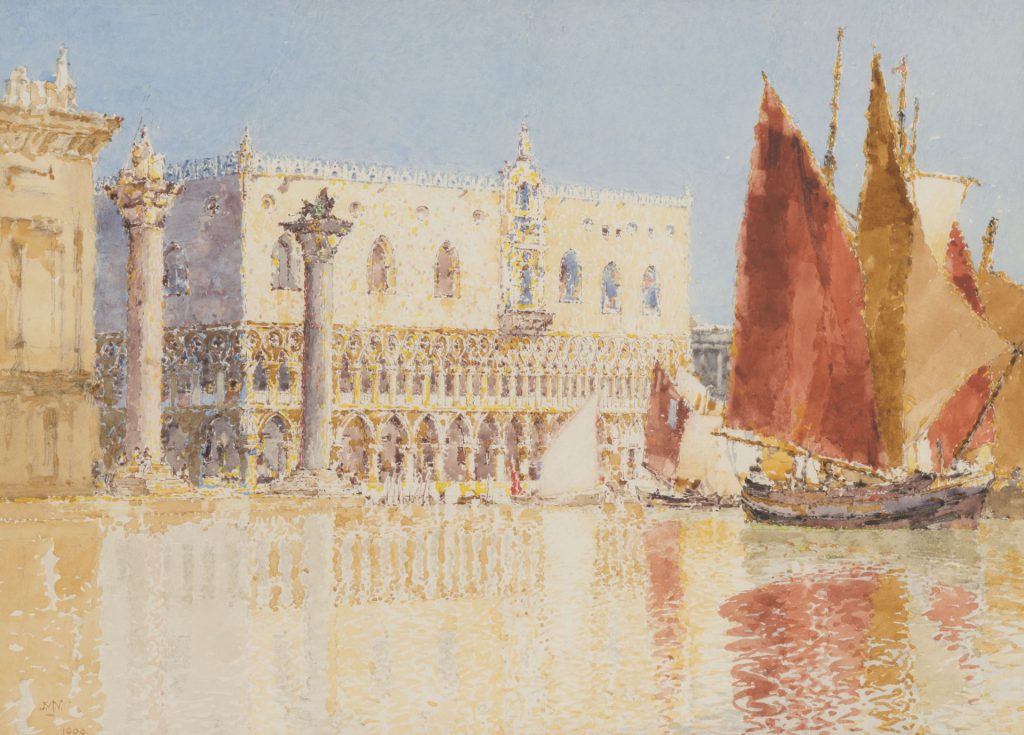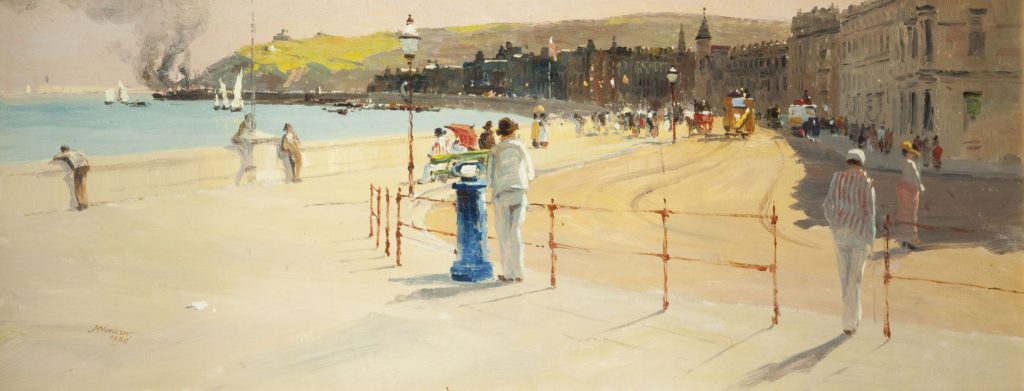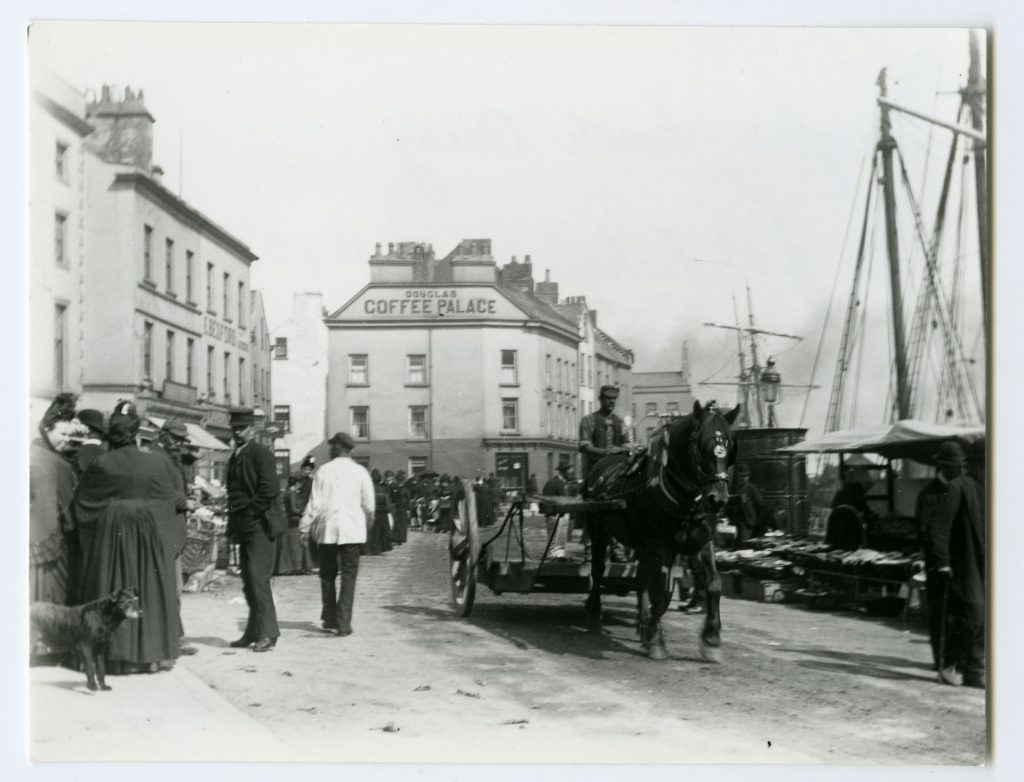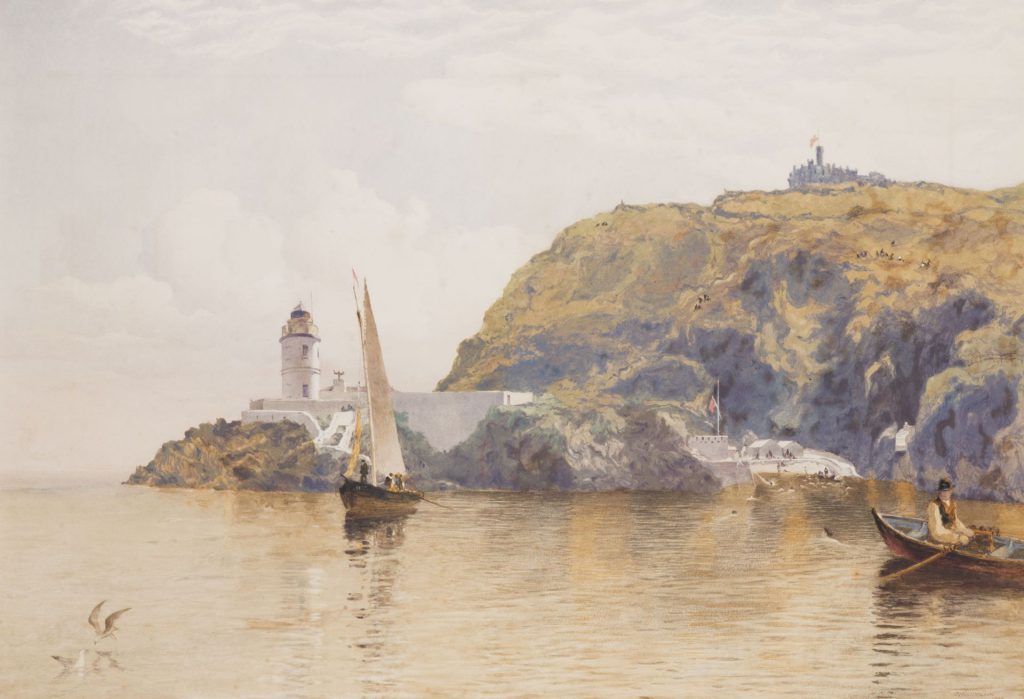John Miller Nicholson: a Manx National Artist
The following text comes from a series of newspaper articles which were written for the MNH exhibition ‘John Miller Nicholson – A Manx National Artist’ held at the Manx Museum, Douglas – the articles were extended versions of the text on the exhibition graphic panels. One of the aims of the exhibition was to provide visitors with an opportunity to discover for themselves why Nicholson was held in such high esteem as an artist. The exhibition was on display in 2013 and featured a selection of Nicholson’s works including oil paintings, watercolours, pencil sketches, graphic designs and photographs.
An Introduction
Manx National Heritage holds the largest collection of artwork by one of the Isle of Man’s most important artists, John Miller Nicholson. He was considered by his contemporaries and later generations to have been the ‘Manx National Artist’ and ‘one of Manxland’s most gifted sons’. Nicholson’s work was frequently compared to that of Turner, one of Britain’s greatest artists, and was also greatly admired by John Ruskin, the leading Victorian art critic.
But the words of a fellow Manx artist, Archibald Knox, following Nicholson’s death in 1913, show the high esteem in which Nicholson was held by his contemporaries:
…the success he achieved in dealing with colour… accurate in drawing and in the weights of colour; full of a knowledge of light… His skill with pigments was perfect; no modern painter has it in an equal degree…
So who was John Miller Nicholson? Nicholson was a man of many talents – he was a painter and decorator, an artist, a graphic designer, an illustrator, a photographer, a musician but also a family man and a man of faith.
Nicholson was born in Douglas in 1840, the eldest son of an English housepainter, William Nicholson, from Cumberland and Christian Bell. His natural artistic ability was recognised at an early age and encouraged by his mother.
The lad had a proud and independent spirit, a love for the beautiful in form and colour, a talent for music and a determination to master difficulties. Nicholson confessed that he inherited these qualities from his mother.
(J.E.Douglas – personal friend of J.M.Nicholson)
William Nicholson came to the Isle of Man in the 1830s and in 1838 went into partnership with Thomas Gill to start ‘Gill and Nicholson’ – a firm of House, Sign, Furniture and Ornamental Painters, Glaziers and Paper Hangers in Church Street, Douglas. The growing town of Douglas and changing decorative tastes as simple Georgian house interiors were replaced by more ornate and highly decorated Victorian interiors will have ensured that there was plenty of work for William Nicholson and his partner.
In April 1839, William Nicholson married Christian Bell, the daughter of John Bell, a ship’s carpenter from Douglas, at Kirk Braddan (now Old Kirk Braddan Church) and the following year, their eldest child, John Miller Nicholson, was baptised in the same church. By 1841, the business had moved to 3, Well Road, listed in newspaper advertisements as being opposite the Methodist Chapel, if potential customers needed directions to find their new premises in Douglas. The partnership of ‘Gill and Nicholson’ was dissolved in July 1841 but the Well Road premises were to continue to be home to William Nicholson and the next 3 generations of the Nicholson family working as painters and decorators until well into the twentieth century.
In 1844 tragedy struck when Christian Nicholson died and William Nicholson was left a widower with a young family of 3 boys. Nicholson remarried in June 1846 and by 1861, the growing Nicholson family were living at Finch Road.
John Miller Nicholson was educated at the Douglas Diocesan Grammar School and specialised in his art lessons in lettering, a skill that would have been of great use in his later work in illustration and graphic design. When he left school, he became an apprentice painter and decorator in his father’s business on Well Road (later to be named Well Road Hill and now on the side of the Chester Street carpark in Douglas). But while learning his trade, Nicholson continued to draw and paint and spent several years copying pictures, photographs and designs to improve his art. Manx National Heritage has several pen and ink drawings in the National Art Collection from Nicholson’s studio that show how his artwork developed through the 1860s and early 1870s. He developed from being a competent amateur artist into a well-regarded professional artist with a growing reputation.

Watercolour sketch: ‘Douglas Promenade from bottom of Broadway, Oct. 1868 from a stereo slide’ (1993-0191/1)
Nicholson’s aim in his artwork was, like the Pre-Raphaelite Brotherhood, to be a truthful realist and to capture every detail however minor and insignificant and to represent what one saw without embellishment or gloss. A lifelong fascination with the sea and maritime life can be seen in Nicholson’s work and the visual record he produced of life and work around Douglas harbour is not one of artistic license and ‘creativity’ but an accurate and truthful vision where seamen could have identified their own vessel and even counted the links on the chains mooring the vessels
By the end of the 1870s, Nicholson’s artwork had reached the peak of perfection in terms of detail and subtlety of colour and tone but he was also a very modern artist – he broke the rules of classical composition – there was no central focus to a picture, objects and people were and could be cut off at the edges.
By this time, Nicholson and his artwork had attracted important and influential admirers, such as Lady Loch, the wife of the Island’s Lieutenant Governor. As a result of this patronage, Nicholson came to the attention of John Ruskin, a leading champion of the new Arts and Crafts movement. Ruskin was so impressed that he bought several of Nicholson’s pencil sketches and then donated them to several public art galleries around Britain.
The Journey to Venice – An Artistic Transformation
Although John Miller Nicholson’s ‘day job’ was as a painter and decorator and one half of the family business of Nicholson Brothers, he was achieving increasing recognition both on and off the Island as an artist of great merit. Nicholson had even been advised in 1880 by the great art critic of the day, John Ruskin, to travel to Italy to (quite) literally broaden his horizons.
…you are cramped and chilled by Isle of Manishness. You ought to take knapsack on shoulder, a grey paper book – half a dozen colours and a bit of chalk – and so walk to Naples and back…
So in 1882, the 42 year old Douglas painter and decorator (and married father of 2), John Miller Nicholson, made the long and probably arduous journey from the Isle of Man to Italy.
The final destination and highlight of the trip was Venice – a beautiful and enthralling city that has attracted and captivated the hearts and souls of poets, artists and writers for centuries. It was one that Nicholson would have had some impressions of, possibly through reading John Ruskin’s The Stones of Venice (1851-3), but definitely by copying architectural drawings of Venetian buildings in ‘The Building News’.
As Ruskin had predicted, what Nicholson saw in Venice, changed his art forever. He no longer needed or wanted to capture the world around in precise photographic detail, instead he wanted to capture light – the fleeting moment – an impression of light changing by the second.
A new chapter had began in Nicholson’s artistic career and 30 years after his trip, Nicholson was still painting views of Venice using the drawings he had made during that memorable trip to Venice at Easter, 1882.
It is likely that Venice with its working quaysides and views of boats across the lagoon, held the same magic and fascination for Nicholson that Douglas with its working harbour and views out to sea had done from his earliest childhood memories. This fascination with maritime life can be seen in many of Nicholson’s drawings, photographs, watercolour, oils and design work – never is Nicholson more in control of a pencil, brush or camera than when recording boats and harbour scenes.
Having been freed from the constraints of recording everything in photographic and miniscule detail – a moment of reality frozen in time. Nicholson now felt able to capture the light and movement of life as it passed by, with images that were less sharply focussed and showed the life and vitality of the world around him. No longer a Pre-Raphaelite concerned with capturing every detail, Nicholson was now an Impressionist artist with a new vision for the future.
John Miller Nicholson – A New Impressionist Artist
Following John Miller Nicholson’s memorable trip to Venice in 1882, taken on the advice of John Ruskin, one of the leading art critics of the 19th century, a new chapter was opened in Nicholson’s artistic career. Nicholson returned from his life-changing trip to Venice with a new artistic vision. The fine and detailed brushstrokes of his earlier work were replaced with a broader and looser style of painting, now he wanted to capture light and the fleeting moment.
Nicholson was no longer concerned with capturing every detail of a scene but rather the spirit and character of a place. His attention was now committed to colour, light and shade and most importantly the atmosphere of a scene.
As a result under Nicholson’s paintbrush, views of Douglas promenade began to look like the elegant promenades of the French Riviera and the old Douglas market became a Parisian street market, full of hustle and bustle.
Apart from rare examples such as a painting of Peel Castle with an inscription saying it was painted in 3 hours, his oil paintings were not painted from life. Instead they were based on preliminary sketches and sometimes on photographs. Although the sketches were annotated with a wealth of detail regarding time of day, weather conditions and colour, Nicholson also demonstrated a great ability to recreate the atmosphere of a scene in the large oils he painted in his studio. This ability is seen to its greatest extent in the paintings he produced of Venice, some painted up to 30 years after his visit in 1882. The time he had spent as a young man laboriously practicing and repeating exercises in developing a visual memory went on to pay great dividends in his later artistic career. By studying an artwork or scene and then drawing or painting it from memory, he was refining a skill that would allow him to reproduce scenes he had seen several years earlier. As a result, Nicholson would reproduce scenes in oils that contained a freshness and vitality that the viewer would feel the artist had captured directly from life only a moment before. This is most vividly seen in Nicholson’s magnificent oil painting of St Mark’s Cathedral and Square in Venice, originally captured in a tiny pencil sketch in 1882 but reproduced in its full colourful glory in oils in 1907.
However greatly appreciated Nicholson’s artwork was by both his contemporaries and the Isle of Man, there was always a concern and one that grew after his death that he had not achieved the recognition and status it truly deserved. As a self-taught artist, Nicholson’s lack of formal training was felt by some to have prevented him from achieving his full potential. In a review of J.E.Douglas’s biography of John Miller Nicholson, the reviewer said:
Not until he was able to visit Italy in middle life did he receive assistance which, if available in his youth, might well have made him one of the world’s great master painters.
Following his trip to Venice, Nicholson could easily have chosen to move with his family to England and have forged a highly successful career as an artist in England and most likely have found national, if not international, recognition and prestige. He had travelled to Italy and was exhibiting at the prestigious Grosvenor Gallery in London, what was there now to stop him? But Nicholson did not move to England or even give up his ‘day job’ as one half of the family painting and decorating business, Nicholson Brothers. Instead Nicholson stayed on the Isle of Man running the family business of painters & decorators with his brother, but he was able to spend the next 30 years doing what he most enjoyed – painting, drawing and photographing the world he saw around him on the Island. So maybe the artist who could have been Britain’s greatest Impressionistic artist chose a life with family and friends on the island that he dearly loved over possible, but potentially fleeting, fame in London – a loss to wider British art but a great gain to the Isle of Man.
Whether painting views of Venice or of his home town of Douglas, Nicholson painted what he saw with a quality and beauty that still has the capacity to fascinate and captivate viewers as much now as when they were first seen over a hundred years ago.
John Miller Nicholson – Recording the World with a Camera
His artistic and creative nature was not just confined to the use of a pencil and a paintbrush, he was also interested in the creative possibilities of the camera, one of many 19th century technological innovations. In the 1860s, when he was constantly copying illustrations and engravings in books and periodicals, he would also use stereoscopic slides of views of the Isle of Man as the basis for his drawings. These early photographic views would be replicated in minute detail as Nicholson endeavoured to reproduce exact copies of the images. This fascination and determination to record a scene as faithfully as the camera was able to do can be seen throughout Nicholson’s drawings and watercolours of the 1860s and 1870s. No longer did he have to rely on his memory alone to recreate a moment in time in his detailed watercolour and oil paintings, instead he created drawings that were as detailed as the photographs he had previously been copying.
By the late 1880s though, Nicholson no longer had to rely on his detailed drawings: now he could consider photography as a way to record the daily life going on around him. Whilst most cameras in the 1880s and 1890s were large plate cameras used to produce studio portraits, a new type of camera was being developed that opened up a whole new world of artistic possibility. Instead of taking a large camera and tripod out into the street to document urban life, now photographers could use a small handheld camera.
Nicholson took a vast quantity of photographs around Douglas providing us today with a fascinating record of daily life along the North Quay and Promenade. No longer encumbered with a heavy camera and tripod, photographers such Nicholson could now go out onto the streets and capture life as it happened and create the new photographic genre of ‘Street Photography’. As a result, Nicholson was able to capture scenes such as a market stall on the quayside falling over, children playing on the beach as yachts sail past in the background or tourists walk along Douglas Promenade enjoying their time at the seaside. The ‘snapshots’ of daily life that Nicholson had spent years trying to capture in his art, he could now capture for posterity in a photographic image. These images, together with his pencil sketches, provided the basis for a wealth of artwork.
John Miller Nicholson – All of Life Recorded in a Sketchbook
Nicholson appears to have been a natural draughtsman from a young age and it was a skill that he would continue to practice and hone to perfection throughout his artistic career. Although young artists are always told to keep a notebook to hand and to practise their drawing and sketching every day and at any opportunity, very few ever follow this advice for more than a few weeks or months. In contrast though, Nicholson appears to have taken this artistic advice very much to heart and produced vast quantities of pencil sketches throughout his life and appears always to have kept a small sketchbook and a pencil in his pocket. As a result, these small hardback notebooks provide a visual diary of Nicholson’s life from at least 1867 (the date of the earliest notebook in Manx National Heritage’s collections) through to the 1900s.

Drawing of a plaster cast not from life, study of human form and shadows. Entitled at base ‘J.M. Nicholson Dec. 1868 from a Plaster Cast’ (1993-0275)
Nicholson’s notebooks are filled with everything from sketches of small details on buildings and a single figure in a crowd to fully annotated sketches of the Douglas quayside or a scene in Venice. But they were also part of his daily working life and contain notes and details for painting and decorating jobs that were carried out by the family firm of Nicholson Brothers, which he ran with his brother James Bell Nicholson. The notebooks even provided Nicholson with somewhere to write the addresses of fellow artists and record the prize winners of the Douglas School of Art annual art competition as he made his decisions as one of the judges – one of those winners was a young Archibald Knox.

and ink sketch: Bird’s Eye View of Castle Street, Douglas, 1868 (reference/ accession number: 1993-0243/2)
Although the pencil sketches can now appreciated as great works of art in their own right, at the time Nicholson would have viewed them primarily as a visual record of a scene and the basis for a later more detailed watercolour or oil painting. As part of the recording process, he would meticulously add details of the date and time that the drawing was made together with any notes he felt he might need at a later date regarding the colours and lighting conditions. It is fascinating to realise that Nicholson might still be using original drawings he had made up to 30 or more years later to produce a painting – as he did with his 1882 drawings of Venice. The amount of fine detail to be found in the pencil sketches and the volume of annotations at the side of a drawing can belie the size of the actual sketch, which are far smaller than one would expect for the detail they contain. The sketches are often 9-10cm by 16-18cm in size and the fine pencil lines of the sketches and miniscule writing indicate that Nicholson did keep a well-cut, sheathed pencil in his pocket at all times and that he must have had extremely good eye-sight in his 30s and 40s. Through his pencil sketches, Nicholson has also provided us with an invaluable historic record of the Douglas that surrounded him in the 1880s and one that is as evocative now of times gone by as they were in the past:
In the Spring of each year many weeks were spent by the artist [Nicholson] sketching and painting groups of vessels and buildings near the harbour. A favourite station point was Blore’s corner [now near the Harbour Bridge on North Quay, Douglas]. Nicholson would often be seen seated on a mooring post busy with his pencil and undisturbed by the onlookers who clustered behind him to watch the progress of the drawing. On one occasion he was drawing part of an old ketch that lay alongside the South Quay. The old skipper, who was lounging listlessly on the deck of his ship, had his curiosity aroused and came ashore. He stood watching Nicholson at work. When the sketch was nearly finished the old skipper said: “ O’ill stan’ yer half a quid for it.” “Cannot sell,” said Nicholson; “it is only a study and of little use to you. May I ask why you are so anxious to have the drawing?” “Well, Guv’nor,” said the skipper, “Oi’ll give you a quid for it. You see, I want that drawin’ of the old ship, for my father and my mother was drowned in her.”
John Miller Nicholson – A Man of Faith
One aspect of Nicholson’s life that may not be so well-known now is that of his religious faith and how his religious, artistic and creative lives were intertwined. As a young man he had played the flute in the orchestra of the Wesleyan Methodist Chapel on Well Road Hill, Douglas (directly opposite what became the Nicholson family firm’s workshop and studio) before a church organ had been installed. He had also performed in charity concerts held in Douglas raising funds for good causes such as the Douglas Hospital.
The church that John Miller Nicholson was most closely associated with was St Thomas’s Church in Douglas, where he appears to have been a most loyal and active member of the congregation and whose contribution to church life extended far beyond attending weekly services. The church was opened in 1849, although not formally consecrated until 1872, and was designed in a 12th century Gothic style by the Manx architect, Ewan Christian. The Reverend E.B.Savage (later to become Canon Savage) was appointed Vicar in 1882 and his interest in history and church architecture led him to proposing a sympathetic decorative scheme of Medieval-style murals for the interior of St Thomas’s Church. At the Easter Vestry Meeting of 1896, it was decided to approach John Miller Nicholson to prepare plans for the church decoration. By the time of the next Easter Vestry Meeting for St Thomas’s Church in 1897, Nicholson’s plans had been approved by the Lord Bishop.

Pen and ink drawing: ‘No. 4 Freehand (Brush) Dec. 1870 – The Building News, May 19th 1865 -Church at Marisset near Beauvais’ (1993-0081/1)
Although the initial work on the chancel had been completed within a year (1896-7), a series of issues including the need to raise extra funds and the Manx financial crisis caused by the collapse of Dumbell’s Bank in 1900, meant that the decoration of the nave was not completed until 1910.
The final part of the Church decoration, above and below the church galleries was sadly never completed, due in the main to the deaths of John Miller Nicholson in 1913 (who had personally supervised the painting of the murals, as well as designing them) and his brother, James Bell Nicholson in 1905 (who had painted the inscriptions/ lettering on the murals) and finally Canon Savage leaving the Island to take up a new post in England in 1914 – it was the end of an era but one that had left a lasting and beautiful memorial that can still be seen today at St Thomas’s Church.
Nicholson worked on various other church interiors including the decoration of the chancel of St Barnabas, the interior of the Loch Parade Primitive Methodist Chapel in Douglas (1889-90) and St Andrew’s Scottish Presbyterian Church in Douglas (1899). The firm of Nicholson Brothers had become well-known on the Island for specialising in ecclesiastical decoration.
John Miller Nicholson – An Artistic Legacy
Over an artistic career spanning several decades, Nicholson established himself as a highly regarded artist who could work in a wide variety of different styles and mediums including oils, watercolours, pencil sketches, graphic designs and photography. But however highly regarded Nicholson may have been on the Isle of Man, many felt that he never achieved the greater recognition that he should have received as one of Britain’s most important late 19th century artists. This was a recurring theme in many of the obituaries that followed his death in March, 1913.
…but for his invincible aversion to anything in the nature of popular applause, it is well nigh certain that he would have ranked with the greatest of Victorian artists… Now that he is dead, his work will speak for itself, and so speaking will ensure for its author that great reputation as an artist which, as a consequence of his own shyness and retiring disposition, he never thoroughly achieved while alive.
(Memorial Notice for J.M.Nicholson, Manx Quarterly, 1913)
Nicholson’s legacy can not only be seen in terms of paintings on a gallery wall, but also in bricks and mortar. In 1880, Nicholson, together with Governor Loch and his wife (later Lord and Lady Loch) had been instrumental in helping to form the Douglas School of Art, later to be housed in a purpose-built art school in Kensington Road, Douglas. Although Nicholson may have been entirely self-taught, he helped to ensure that future generations of Manx students and artists were able to benefit from an art education that he himself had lacked growing up. The first year of students at the Douglas School of Art included a young Archibald Knox, who went on to design for Liberty and become one of leading the 20th century designers. Students from the Douglas School of Art have gone on to become Professors of Art and Royal Academicians and even included John Miller Nicholson’s own grandson, John H.Nicholson, who became a leading Manx artist in his own right. John H.Nicholson designed everything from Manx stamps to Manx banknotes and coins, as well as producing testimonials and illuminated addresses like his grandfather before him. This artistic legacy continues at the Isle of Man College and can be seen every year as a new generation of Manx artists start on their own artistic careers.
But maybe Nicholson’s greatest legacy is the idea that anyone can aspire to be a great and talented artist, even a young painter and decorator from Douglas.
Yvonne M. Cresswell (MNH Curator of Social History)
Blog Archive
- Edward VII’s Coronation Day in the Isle of Man (9 August 1902)
- Victoria’s Coronation Day in the Isle of Man (28 June 1838)
- Second World War Internment Museum Collections
- First World War Internment Museum Collections
- Rushen Camp: Second World War Internment on the Isle of Man
- Hutchinson, Onchan & Peveril Camps: Second World War Internment on the Isle of Man
- Douglas Promenade: Second World War Internment on the Isle of Man
- Mooragh Camp: Second World War Internment on the Isle of Man
- Sculpture collection newly released to iMuseum
- Fishing Folklore: how to stay safe & how to be lucky at sea
- News from the gaol registers project: remembering the men and women who served time in Castle Rushen
- Explore Mann at War: stories of Manx men, women and children in conflict
- We Will Remember Them: Isle of Man Great War Roll of Honour (1914-1918)
- Dr Dave Burnett explores Manx National Heritage geology collection
- Unlocking stories from the Archives: The Transvaal Manx Association
- Login to newspapers online: step-by-step guidance
- ‘Round Mounds’ Investigation Reveals Rare Bronze Age Object


